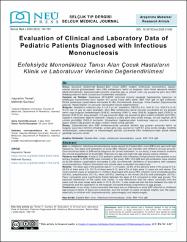| dc.contributor.author | Temel, Hayrettin | |
| dc.contributor.author | Gündüz, Mehmet | |
| dc.date.accessioned | 2021-02-02T07:03:03Z | |
| dc.date.available | 2021-02-02T07:03:03Z | |
| dc.date.issued | 2020 | en_US |
| dc.identifier.citation | Temel, H. ve Gündüz, M. (2020). Evaluation of clinical and laboratory data of pediatric patients diagnosed with infectious mononucleosis. Selcuk Medical Journal, 36(3), 184-191. https://doi.org/10.30733/std.2020.01462 | en_US |
| dc.identifier.issn | 1017-6616 | |
| dc.identifier.issn | 2149-8059 | |
| dc.identifier.uri | https://doi.org/10.30733/std.2020.01462 | |
| dc.identifier.uri | https://hdl.handle.net/20.500.12511/6475 | |
| dc.description.abstract | Aim: In childhood, infectious mononucleosis cases caused by Epstein-Barr virus (EBV) are seen with high frequency. The signs and symptoms of acute EBV infection can manifest with different clinical pictures. Care should be taken in differential diagnosis for correct treatment. In our study, it was aimed to examine the clinical presentation of acute EBV infections by age and high-risk age groups among children. Patients and Methods: A total of 337 pediatric patients with infectious mononucleosis who applied to our tertiary hospital in 2013-2020 were included in the study. EBV VCA IgM and IgG antibodies were studied by ELISA method (quantitative microplate ELISA, Euroimmun®, Germany) in accordance with company recommendations. Patient information and results were evaluated retrospectively. Results: The mean age of the patients was 5.1 ± 3.4 years. 22.8% of the patients were in the group of 0-2, 43.0% of them were 3-5, 29.7% of them were 6-12, and 4.5% of them were 12 years old and above. The most common signs or symptoms in children diagnosed with acute EBV infection were lymphadenopathy (59.6%), lymphocytosis (45.1%), fever (40.9%), swelling in the throat (39.2%) and pharyngitis (30.0%). Fever complaints were significantly higher between the ages of 3-5 compared to other age groups. The seasonal distribution of the cases was similar. It was determined that the cases increased over the years and the most cases were seen in 2019 (23.4%). It was observed that the time between the start of complaints and the application to the hospital increased directly proportional to age groups. Conclusion: In our study, it was concluded that there was no difference in acute EBV infection in childhood age groups in terms of signs and symptoms, and the number of cases increased slightly over the years, especially in children with lymphadenopathy, splenomegaly and hepatomegaly. | en_US |
| dc.description.abstract | Amaç: Çocukluk döneminde Epstein-Barr virüsü (EBV) nedenli enfeksiyöz mononükleoz olguları yüksek sıklıkta görülmektedir. Akut EBV enfeksiyonu belirti ve bulguları farklı klinik tablolarla kendini gösterebilmektedir. Çalışmamızda çocuklar arasında yaş ve yüksek riskli yaş gruplarına göre akut EBV enfeksiyonlarının klinik sunumunun incelenmesi amaçlandı. Hastalar ve Yöntem: Çalışmaya 2013-2020 yıllarında üçüncü basamak hastanemize başvuran ve enfeksiyöz mononükleoz tanılı toplam 337 çocuk hasta dahil edildi. EBV VCA IgM ve IgG antikorları ELISA yöntemiyle (quantitative microplate ELISA, Euroimmun®, Almanya) firma önerileri doğrultusunda çalışıldı. Hasta bilgileri ve sonuçları retrospektif olarak değerlendirildi. Bulgular: Hastaların ortalama yaşı 5.1±3.4 yıl idi. Hastaların %22.8’si 0-2, %43.0’i 3-5, %29.7’si 6-12, %4.5’i ise 12 yaş ve üzeri gruptaydı. Akut EBV enfeksiyonu tanısı konulan çocuklarda en sık görülen belirti veya bulgular lenfadenopati (%59.6), lenfositoz (%45.1), ateş (%40.9), boğazda şişlik (%39.2) ve farenjit (%30.0) idi. Ateş şikayeti, 3-5 yaş arasında diğer yaş gruplarına göre anlamlı yüksekti (p=0.003). Olguların mevsimsel dağılımı benzerdi. Olguların yıllara göre artış içinde olduğu, en çok olgunun 2019 yılında görüldüğü (%23.4) belirlendi. Şikayetlerin başlamasından hastaneye başvuru yapılana kadar geçen sürenin yaş grupları ile doğru orantılı olarak arttığı görüldü. Sonuç: Çalışmamızda akut EBV enfeksiyonunda çocukluk dönemi yaş grupları arasında belirti ve bulgular açısından farklılık olmadığı, yıllara göre olgu sayılarının hafif bir artış içinde olduğu, özellikle lenfadenopati, splenomegali ve hepatomegali görülen çocuklarda EBV enfeksiyonundan şüphe etmek gerektiği sonucna varıldı. | en_US |
| dc.language.iso | eng | en_US |
| dc.publisher | Necmettin Erbakan University | en_US |
| dc.rights | info:eu-repo/semantics/openAccess | en_US |
| dc.rights | Attribution-NonCommercial 4.0 International | * |
| dc.rights.uri | https://creativecommons.org/licenses/by-nc/4.0/ | * |
| dc.subject | Epstein-Barr Virus | en_US |
| dc.subject | Infectious Mononucleosis | en_US |
| dc.subject | Child | en_US |
| dc.subject | EBV VCA Igm | en_US |
| dc.subject | Epstein-Barr Virüsü | en_US |
| dc.subject | Enfeksiyöz Mononükleoz | en_US |
| dc.subject | Çocuk | en_US |
| dc.subject | EBV VCA IgM | en_US |
| dc.title | Evaluation of clinical and laboratory data of pediatric patients diagnosed with infectious mononucleosis | en_US |
| dc.title.alternative | Enfeksiyöz mononükleoz tanısı alan çocuk hastaların klinik ve laboratuvar verilerinin değerlendirilmesi | en_US |
| dc.type | article | en_US |
| dc.relation.ispartof | Selcuk Medical Journal | en_US |
| dc.department | İstanbul Medipol Üniversitesi, Tıp Fakültesi, Dahili Tıp Bilimleri Bölümü, Çocuk Sağlığı ve Hastalıkları Ana Bilim Dalı | en_US |
| dc.authorid | 0000-0002-6490-4530 | en_US |
| dc.authorid | 0000-0003-4479-3404 | en_US |
| dc.identifier.volume | 36 | en_US |
| dc.identifier.issue | 3 | en_US |
| dc.identifier.startpage | 184 | en_US |
| dc.identifier.endpage | 191 | en_US |
| dc.relation.publicationcategory | Makale - Ulusal Hakemli Dergi - Kurum Öğretim Elemanı | en_US |
| dc.identifier.doi | 10.30733/std.2020.01462 | en_US |



















